Filament Winding Overview
Filament winding is an automated method for creating composite structures by winding filaments under tension over a rotating mandrel (tool). The fibre placement is guided by a machine with two or more axes of motion, as can be seen in the simple schematic diagram below. Filament winding a used to manufacture a range of products such as pipes, pipe joints, drive shafts, masts, pressure vessels, storage tanks etc. There are a number of different types of filament winding machine that are best suited to manufacturing different type of components
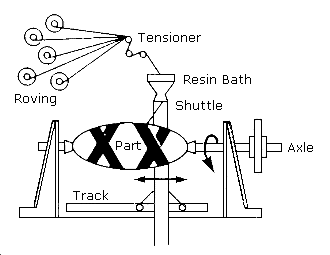
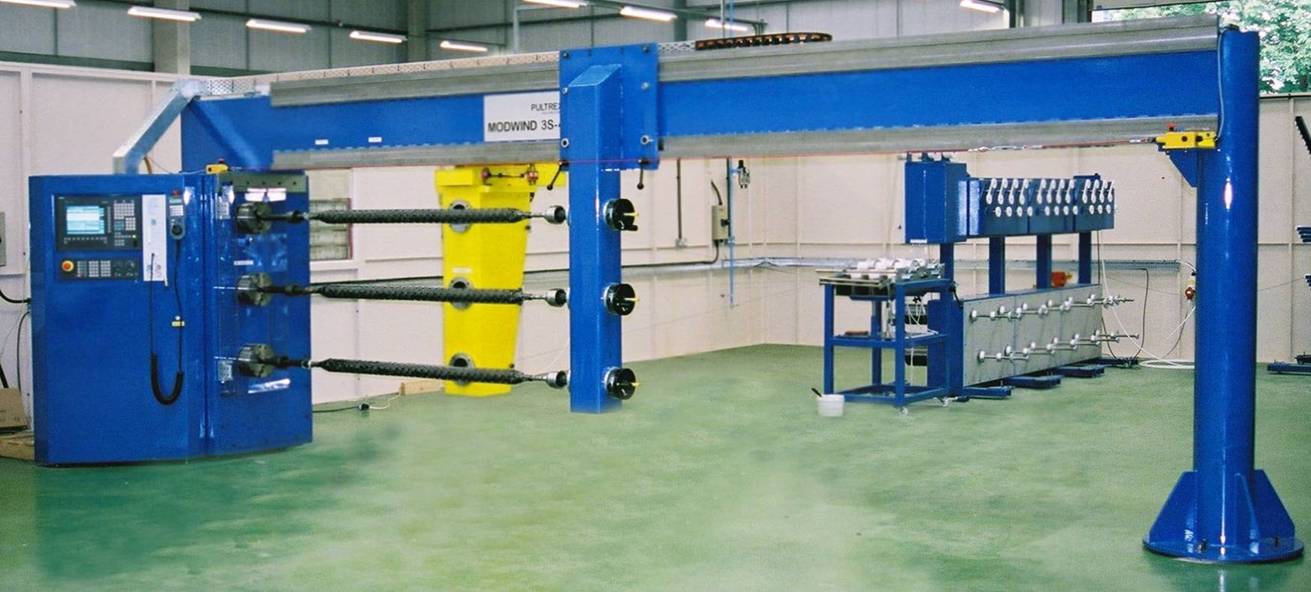
Filament Winding Machines
The simplest winding machines have two axes of motion, the mandrel rotation and the carriage travel (usually horizontal). Two-axis machines are best suited to the manufacture of pipes only. For pressure vessels such as LPG or CNG containers (for example) it is normal to have a four-axis winding machine. A four-axis machine additionally has a radial (cross-feed) axis perpendicular to carriage travel and a rotating fibre payout head mounted to the cross-feed axis. The payout head rotation can be used to stop the fibre band twisting and thus varying in width during winding.
Machines with more than four axes can be used for advanced applications, six-axis winding machines usually have 3 linear and 3 rotation axes. Machines with more than 2 axes of motion have computer/CNC control, however these days new 2-axis machines mostly have numeric control. Computer controlled filament winding machines require the use of software to generate the winding patterns and machine paths, such software can normally be provided by filament winding machine manufacturers or by using independent products such as Cadfil. The Cadfil software can be configured for any computer controlled filament winding machine and also for general purpose 6-axis robots with minor adaptions for filament winding.
Cadfil is supplied configured for the customer’s winding machine. Cadfil can be supplied with multiple machine configurations, the user just selects which machine to use. Cadfil can be configured for 2 to 6 axes and for all filament winding machines types and control systems.
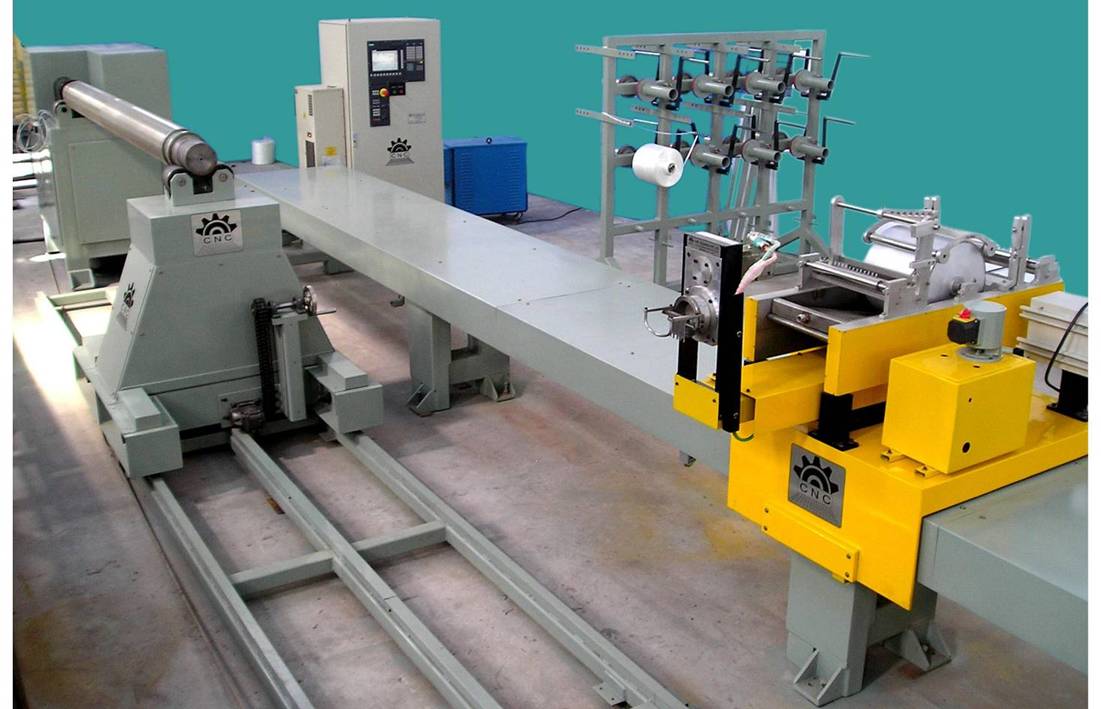
Advantages of Filament Winding.
Filament winding is one of the few Automated Processes for composites manufacture and can thus produce highly repeatable, high quality components at reduced labour content. It is quick and reliable technology for making high performance parts. A big advantage of filament winding is that it used continuous fibres which leads to very good material properties for both strength and stiffness. There is also the ability to orientate fibre direction for ‘optimised’ composites. High Fibre volume fractions are possible 60-80% and it can use materials in the simplest (lowest cost) form - Fibre Roving & Resin Winding is accurate, repeatable and gives a high quality internal surface.
Can use all fibre types: E Glass, S-Glass, R-Glass High Strength & High Modulus Carbon Fibre Aramid (Kevlar) HD Polyethylene (Spectra/ Dyneema) Basaltic Fibres Organic (e.g. Hemp Fibre) Esoteric Aerospace Materials ( e.g. Alumina , Silicon Carbide, Boron)
Can use a wind range of matrix (resin) groups: Polyester (versatile ‘best’ cost) Vinyl-ester (improved strength & impact/chemical resistance Epoxy (high strength and higher temperature capability) Phenolic (better fire resistance / low smoke) Bismaleimides (BMI) – higher temperature than epoxies) Thermoplastic matrix - normally in tape form comingled with the fibre
History of the Filament Winding Machine
Early 1960s - First Commercial Winding Machines These machines were cumbersome, mechanical equipment requiring changes to gears, and belts / chains in order to alter a wind angle or wind length, and were mainly used for tubes. Special machines were developed for pressure vessels, including ‘tumble’ winder & polar (spherical) winders. Late 1970s – First computer controlled winding machines. Not very reliable and difficult to program, programming methods were a mixture of calculation, trial & error and ‘teach-in. Early 1980s – First CNC winding machines. Control technology was developing rapidly from companies like Bosch, Fanuc, NUM & Siemens. These control systems were focused on metal cutting (Milling and Turning) but being general purpose could be used for filament winding. The need for improved programming methods to take advantage of the new technology was clear.
Types Of Filament Winding Machine - Advantages and Disadvantages
Historically there have been many types of winding machine however these days there are 2 main types of machine use commercially for most applications the are the overhead beam machine (Goal post machine) like the Pultrex machine in the top picture, and the 'Bed ' type machine as in the CNC Technics machine in the lower figure. Both of these machines are 4 axis with CNC control.
Goal Post Machine Type - Advantages and Disadvantages
One big advantage of this type of machine is that most of the key mechanical parts are above the winding and so do not as readily become contaminated with resin. The key mechanical parts in this case are the slides, racks/pinion, cable tracks, motors etc for the cross/feed and carriage axis and if well designed the motor for the rotating eye axis. This can lead to a longer service life. Access to the mandrel and fibre delivery route is very good with this type of machine, the mandrel can be accessed easily from both sides. Mandrel removal via an overhead crane is not so good as the beam is in the way so the mandrel must be removed from the front and only, with care needed to clear the beam. This machine is best suited to machines up to about 8m long as the stiffness requirement for the overhead beam starts to become an issue. if the beam is not stiff enough this can lead to vibration which can limit the speed of the machine operation. With this type of machine the resin bath and fibre creel stand is normally mounted on the floor some distance behind the machine which tends to give a large floor area for the winding unit.
Bed Machine Type - Advantages and Disadvantages
This type of machine has good access via overhead crane and is good for large mandrels and long machines. Access to the mandrel for a trolley or forklift is only from the front. As the bed is bolted to the floor the machine can be rigid and there is no length limitation like with the beam machine. More care needs to be taken with design to ensure the mechanical parts to not get contaminated with resin and as such they tend to be less accessible. With this type of machine the resin bath is normally mounted on the machine carriage so it is more suitable for large numbers of simply tensioned (by friction devices at the bath) rovings of the centre unwind type. It is also possible to have a carriage with the fibre creel unit mounted on it which reduces the overall working area of the machine and manages the fibre routing/tension in a better or simpler way.
Winding With Industrial Robots
In recent years standard industrial robots (or customised Industrial robots) have been employed. The big players in the field worldwide are the likes of ABB, Kuka and Fanuc. At Cadfil we have experience of working with Kuka and ABB robots but in principal any robot with the standard functionality and a high level programming language can be used. Kuka robots use KRL (Kuka Robot language) and ABB robots use the RAPID language. Some detailed knowledge of the workings of the robot and the robot language is required to utilise such equipment for the filament winding process which has some aspects and requirements that are quite unlike 'normal' robot applications. There are two primary ways in which a robot can be used, one method is where the robot moves the mandrel and the fibre payout device is at a static position and the second method is where the mandrel is held in a rotating station and the robot moves the fibre payout device.
An illustration of the first case can be seen below. In this diagram the Motion Z is analogous to the winding machine linear carriage, X is the transverse (radial) motion and A is the mandrel rotation. All of these are motions of the robot. The rotating eye can be replicated by an external axis (controlled by the robot controller) that rotates the otherwise static fibre payout device. This rotation is labelled E1. For normal winding motion the external axis E1 is must be synchronised with the other robot motions. In the second robot picture the external axis E1 had been eliminated and the bottle is orientated to the totally static payout eye making more full use of the robot axes available.
There are advantages and disadvantages to these two control methods. The method or orientating the bottle requires no external axes so it eliminates a set of additional controls that need to be purchased and integrated into the system, it is substantially much more complex to program, however, this is not actually a problem if you are using Cadfil software as this takes care of such matters. If the mandrel is long and/or has a large inertia is might be better to use the external axis method for the eye orientation because this puts a lower demand on the power of the robot. The robots in the pictures as 210kg capacity and has no issue at all manipulating the gas bottle in the picture at rapid velocity. If one opts for the E1 external axis for the eye it is possible to use a "4 axis palletising robot" without the "wrist action" which may be a slightly better cost than the standard 6 axis robot.
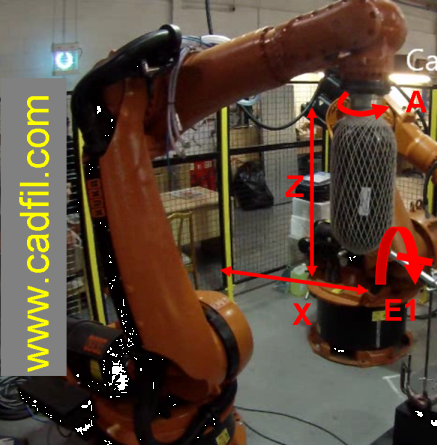
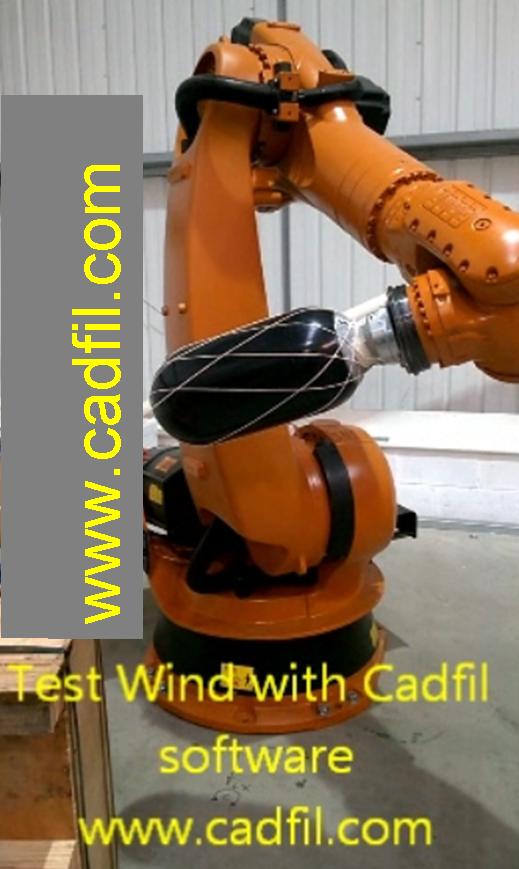
Below we have an ABB robot using and external rotating station to rotate the mandrel.
A tape is being dispensed by the robot which positions the tape in X,Y and Z and orientates
it to remove all shearing and twisting to that is laid to the surface without wrinkles. In this example a small
robot is being used with only 5kg capacity. For winding with normal rovings, these can be guided into the payout eye from external tensioners.
Care must be taken in routing and guiding the fibres to avoid contact with the moving parts of the robot over the operating range of the winding.
An advantage of this method over holding the mandrel in the robot is that larger mandrels can be be used. A disadvantage is that more
external
hardware is required to be integrated into the system and for winding with rovings more effort is required to maintain consistent fibre tension and
to avoid contaminating the robot with resin.
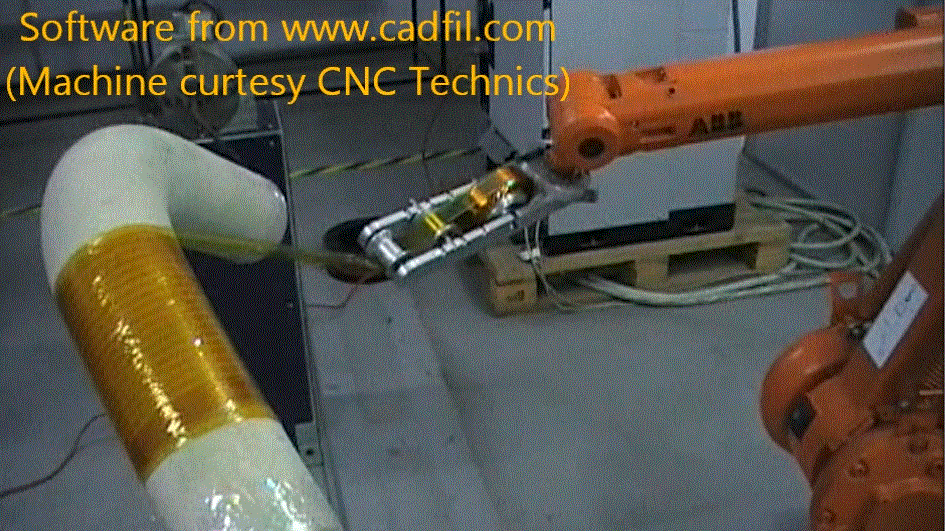
Winding With Industrial Robots to Summarise
Robots give some interesting options for filament winding. A 6 axis robot is a standard machine that is readily available worldwide at a commercially viable price. It has the facility (with the right software) for precise and complex 6 axis control. The robot can make a flexible and scalable winding machine. As the business expands just buy more robots... The reach of any arm robot is limited so this is not very suitable for long parts (perhaps > 4000mm). It is possible to mount a robot on a track system to extend the length however does it really make much sense to move a couple of tonnes (or more) of robot up and down a track at speed when all you are actually wanting to do is move some fibres around? Buy a standard winder from one of the many vendors. Again if you are needing to add lots of ancillary hardware to a robot (i.e. custom external axes) the cost benefit of the "standard machine" rapidly evaporates, so buy a standard winder. Robots also have the facility (for the mandrel held by robot method) of automatically loading and unloading the mandrel. That might seem like a great idea (and it is!), but remember if you need to attach and cut the fibre at the start/end that needs a human. Systems for automatically attaching and cutting the fibre exist so there is some potential to reduce labour content from the winding. But remember, all winding operations need a human, fibres break, spools run out etc etc. You can add lots of additional automation that allow you to pay someone to stand around getting bored for most of the time. To gauge the benefits of different levels of automation you need to fully consider value stream mapping of all the interactions and manual work content in the system against the investment needed - talk to some experts! And finally, in may parts of the world there is a greater cost associated with health and safety (safe use) of a robot because it has a wider scope of potential motion.
Development of Cadfil - some history!
University of Nottingham UK, 1976-1986: During this time there were numerous research projects into many aspects of filament winding under Mike Owen (Professor of Reinforced Plastics) & Vic Middleton (Professor of Mechanical Engineering). In 1981 the composites department acquired a 5 axis CNC winding machine and considerable focus was put on exploring the capabilities of winding and developing programming techniques on VAX computer hardware.
1983 – Crescent Consultants Formed: Owen & Middleton formed a private limited company to exploit (under licence) some of the winding technology being developed at the University. The software was converted to run on the IBM PC and was branded under the CADFIL trademark, Computer Aided Design for FILament winding.
1984 – First CADFIL sale: CADFIL was the first independently available off-line programming system of filament winding. Running on an IBM PC with MS-DOS it featured a graphical user interface
TODAY – Continuous Development: More than 30 years after its inception CADFIL is the worlds leading winding software working on the latest Windows systems and is subject to continuous development to meet the changing needs of our global customer base.
Filament Winding Today
Filament Winding is a mature Technology Machines are now becoming standardised and have lower cost. They are now being used in companies of all sizes and are no longer the preserve of defence, aerospace and corporate R&D centres. The main machine types are:
